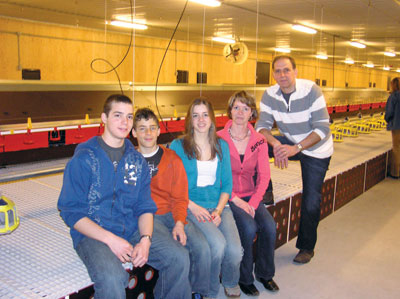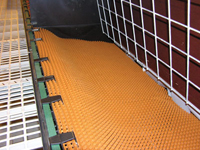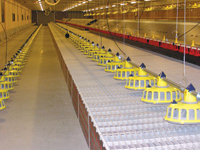
This New Barn ‘Will Work’
Jim Knisley
Features Bird Management ProductionThe Bertens family decided pouring new equipment into an old barn didn’t make sense
Henk Bertens and his family faced a not so simple, but all too common, decision.
It involved lots of money, lots of planning, lots of extremely
technical and detailed decisions and lots of other knowns and unknowns.
 |
|
| MEET THE BERTENS family. Joost, Koen, Anja, Marieke and Henk Bertens (left to right) put their brand new broiler breeder barn on display in early March.
|
Henk Bertens and his family faced a not so simple, but all too common, decision.
It involved lots of money, lots of planning, lots of extremely technical and detailed decisions and lots of other knowns and unknowns.
From the outside it looked to be a simple question of whether to retrofit an old two-storey broiler breeder barn or build a new one.
A retrofit would be less expensive initially, but would never result in a state-of-the-art facility. It would also mean going out of production for a time – perhaps too long a time.
 |
|
| The eggs are guaranteed a safe, soft landing. | |
 |
|
| The Bertenses’ new barn is single-storey and double-wide to give the family the production they need without all the stairs of their older two-storey barn.
|
And while in the grand scheme of things it may be a small matter, the old barn had all those stairs.
At the end of the day, “Investing a lot of money for new equipment in the old barn didn’t make sense to us,” Bertens said.
The family, Henk, Marieke, Koen, Anja, and Joost, bought the farm on Sunshine Line, near Kirkton, Ont., four years ago. It had a barn that was originally built in the early 1980s and expanded in 1989 with new equipment put in. After 20 years the equipment was at the “end of its life,” Bertens said.
So last summer the family tore down an old bank barn to make room for a new broiler breeder barn.
“We decided we didn’t want a new two-storey. Too much running up and down.”
Because he removed the old bank barn, and he now had the space, he decided to go with a double-wide barn, which makes it easier to care for the birds and easier to clean.
Most importantly it was designed with the birds in mind. It has fully modern feed and water systems, a fully insulated floor and automatic roll-away nests.
The Jansen system, supplied by Meller Equipment of Jarvis, promises to reduce labour by up to 50 per cent and keep the eggs clean and minimize cracks. The shape, colour and floor material were chosen to keep floor eggs to a minimum.
The barn is cross-ventilated to accommodate the extra width.
One of the tricks in a broiler breeder barn is ensuring that the males don’t get at the females’ feed and vice versa. In large part this is because the feed formulations are different, but also because the females’ diet is tightly regulated.
The method of accomplishing the separation is elegant in its simplicity and based on the physical differences between the males and females. The males have bigger heads so the female feeders have grills that allow a female head through, but block the large headed males. Meanwhile the males are taller than the females so the male feeders are raised high enough that the females can’t reach them.
The feeding system is fully computerized so the farmer knows exactly how much feed is being delivered and consumed.
The barn itself is 300 feet long and 84 feet wide. There is also a 24-foot by 84-foot service area.
David Kloosterman, of Agrotec, who designed and built the barn, said the double-wide barns began getting popular about 10 years ago. He said they are better than a two-storey as they are easier to maintain and work in. Also going double-wide works out better than doubling the length, which would make a barn far too long.
he insulated floor “makes the birds more comfortable and keeps the barn warmer and drier and makes it easier to clean,” he said.
“There are also fewer health issues with an insulated floor,” he said.
The barn’s roof is also insulated, which helps retain heat in the winter and keeps the barn cooler in the summer. With air intakes on both sides there is good air movement, he said.
The barn is designed to accommodate about 12,000 birds.
Bertens said he decided to hold an open house after the barn was completed and before the birds were brought in because few farmers in the area had ever seen the inner workings of a new broiler breeder operation. The last open house in the area was three years ago and he decided it was time for another one.
As to his new barn, new equipment and the big investment, Bertens was pleased with the result.
“This will work,” he said.
Print this page